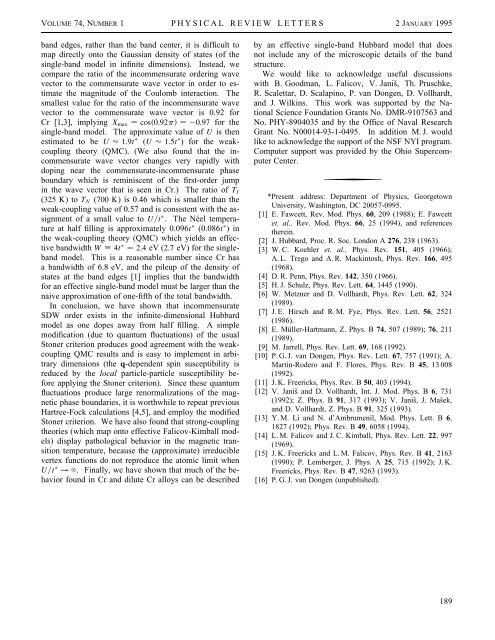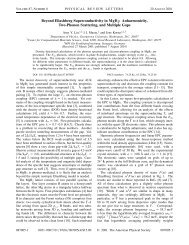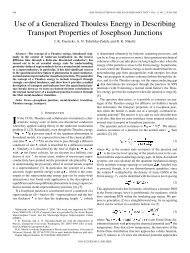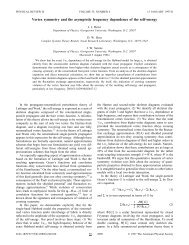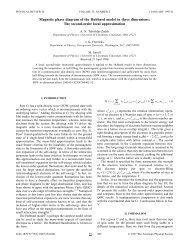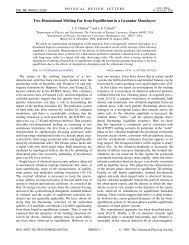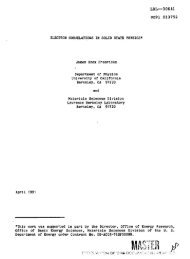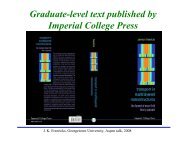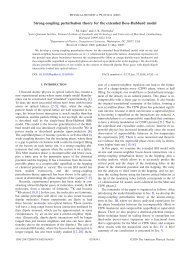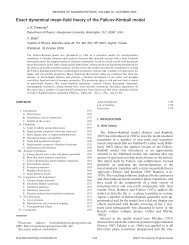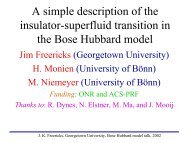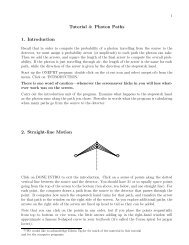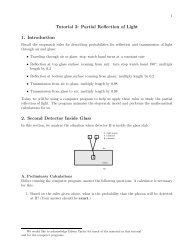Magnetic Phase Diagram of the Hubbard Model - Physics ...
Magnetic Phase Diagram of the Hubbard Model - Physics ...
Magnetic Phase Diagram of the Hubbard Model - Physics ...
You also want an ePaper? Increase the reach of your titles
YUMPU automatically turns print PDFs into web optimized ePapers that Google loves.
VOLUME 74, NUMBER 1 PHYSICAL REVIEW LETTERS 2JANUARY 1995<br />
band edges, ra<strong>the</strong>r than <strong>the</strong> band center, it is difficult to<br />
map directly onto <strong>the</strong> Gaussian density <strong>of</strong> states (<strong>of</strong> <strong>the</strong><br />
single-band model in infinite dimensions). Instead, we<br />
compare <strong>the</strong> ratio <strong>of</strong> <strong>the</strong> incommensurate ordering wave<br />
vector to <strong>the</strong> commensurate wave vector in order to estimate<br />
<strong>the</strong> magnitude <strong>of</strong> <strong>the</strong> Coulomb interaction. The<br />
smallest value for <strong>the</strong> ratio <strong>of</strong> <strong>the</strong> incommensurate wave<br />
vector to <strong>the</strong> commensurate wave vector is 0.92 for<br />
Cr [1,3], implying X max cos0.92p 20.97 for <strong>the</strong><br />
single-band model. The approximate value <strong>of</strong> U is <strong>the</strong>n<br />
estimated to be U 1.9t (U 1.5t ) for <strong>the</strong> weakcoupling<br />
<strong>the</strong>ory (QMC). (We also found that <strong>the</strong> incommensurate<br />
wave vector changes very rapidly with<br />
doping near <strong>the</strong> commensurate-incommensurate phase<br />
boundary which is reminiscent <strong>of</strong> <strong>the</strong> first-order jump<br />
in <strong>the</strong> wave vector that is seen in Cr.) The ratio <strong>of</strong> T I<br />
(325 K) toT N (700 K) is 0.46 which is smaller than <strong>the</strong><br />
weak-coupling value <strong>of</strong> 0.57 and is consistent with <strong>the</strong> assignment<br />
<strong>of</strong> a small value to Ut . The Néel temperature<br />
at half filling is approximately 0.096t (0.086t )in<br />
<strong>the</strong> weak-coupling <strong>the</strong>ory (QMC) which yields an effective<br />
bandwidth W 4t 2.4 eV (2.7 eV) for <strong>the</strong> singleband<br />
model. This is a reasonable number since Cr has<br />
a bandwidth <strong>of</strong> 6.8 eV, and <strong>the</strong> pileup <strong>of</strong> <strong>the</strong> density <strong>of</strong><br />
states at <strong>the</strong> band edges [1] implies that <strong>the</strong> bandwidth<br />
for an effective single-band model must be larger than <strong>the</strong><br />
naive approximation <strong>of</strong> one-fifth <strong>of</strong> <strong>the</strong> total bandwidth.<br />
In conclusion, we have shown that incommensurate<br />
SDW order exists in <strong>the</strong> infinite-dimensional <strong>Hubbard</strong><br />
model as one dopes away from half filling. A simple<br />
modification (due to quantum fluctuations) <strong>of</strong> <strong>the</strong> usual<br />
Stoner criterion produces good agreement with <strong>the</strong> weakcoupling<br />
QMC results and is easy to implement in arbitrary<br />
dimensions (<strong>the</strong> q-dependent spin susceptibility is<br />
reduced by <strong>the</strong> local particle-particle susceptibility before<br />
applying <strong>the</strong> Stoner criterion). Since <strong>the</strong>se quantum<br />
fluctuations produce large renormalizations <strong>of</strong> <strong>the</strong> magnetic<br />
phase boundaries, it is worthwhile to repeat previous<br />
Hartree-Fock calculations [4,5], and employ <strong>the</strong> modified<br />
Stoner criterion. We have also found that strong-coupling<br />
<strong>the</strong>ories (which map onto effective Falicov-Kimball models)<br />
display pathological behavior in <strong>the</strong> magnetic transition<br />
temperature, because <strong>the</strong> (approximate) irreducible<br />
vertex functions do not reproduce <strong>the</strong> atomic limit when<br />
Ut ! `. Finally, we have shown that much <strong>of</strong> <strong>the</strong> behavior<br />
found in Cr and dilute Cr alloys can be described<br />
by an effective single-band <strong>Hubbard</strong> model that does<br />
not include any <strong>of</strong> <strong>the</strong> microscopic details <strong>of</strong> <strong>the</strong> band<br />
structure.<br />
We would like to acknowledge useful discussions<br />
with B. Goodman, L. Falicov, V. Janiš, Th. Pruschke,<br />
R. Scalettar, D. Scalapino, P. van Dongen, D. Vollhardt,<br />
and J. Wilkins. This work was supported by <strong>the</strong> National<br />
Science Foundation Grants No. DMR-9107563 and<br />
No. PHY-8904035 and by <strong>the</strong> Office <strong>of</strong> Naval Research<br />
Grant No. N00014-93-1-0495. In addition M. J. would<br />
like to acknowledge <strong>the</strong> support <strong>of</strong> <strong>the</strong> NSF NYI program.<br />
Computer support was provided by <strong>the</strong> Ohio Supercomputer<br />
Center.<br />
*Present address: Department <strong>of</strong> <strong>Physics</strong>, Georgetown<br />
University, Washington, DC 20057-0995.<br />
[1] E. Fawcett, Rev. Mod. Phys. 60, 209 (1988); E. Fawcett<br />
et. al., Rev. Mod. Phys. 66, 25 (1994), and references<br />
<strong>the</strong>rein.<br />
[2] J. <strong>Hubbard</strong>, Proc. R. Soc. London A 276, 238 (1963).<br />
[3] W. C. Koehler et. al., Phys. Rev. 151, 405 (1966);<br />
A. L. Trego and A. R. Mackintosh, Phys. Rev. 166, 495<br />
(1968).<br />
[4] D. R. Penn, Phys. Rev. 142, 350 (1966).<br />
[5] H. J. Schulz, Phys. Rev. Lett. 64, 1445 (1990).<br />
[6] W. Metzner and D. Vollhardt, Phys. Rev. Lett. 62, 324<br />
(1989).<br />
[7] J. E. Hirsch and R. M. Fye, Phys. Rev. Lett. 56, 2521<br />
(1986).<br />
[8] E. Müller-Hartmann, Z. Phys. B 74, 507 (1989); 76, 211<br />
(1989).<br />
[9] M. Jarrell, Phys. Rev. Lett. 69, 168 (1992).<br />
[10] P. G. J. van Dongen, Phys. Rev. Lett. 67, 757 (1991); A.<br />
Martín-Rodero and F. Flores, Phys. Rev. B 45, 13 008<br />
(1992).<br />
[11] J. K. Freericks, Phys. Rev. B 50, 403 (1994).<br />
[12] V. Janiš and D. Vollhardt, Int. J. Mod. Phys. B 6, 731<br />
(1992); Z. Phys. B 91, 317 (1993); V. Janiš, J. Mašek,<br />
and D. Vollhardt, Z. Phys. B 91, 325 (1993).<br />
[13] Y. M. Li and N. d’Ambrumenil, Mod. Phys. Lett. B 6,<br />
1827 (1992); Phys. Rev. B 49, 6058 (1994).<br />
[14] L. M. Falicov and J. C. Kimball, Phys. Rev. Lett. 22, 997<br />
(1969).<br />
[15] J. K. Freericks and L. M. Falicov, Phys. Rev. B 41, 2163<br />
(1990); P. Lemberger, J. Phys. A 25, 715 (1992); J. K.<br />
Freericks, Phys. Rev. B 47, 9263 (1993).<br />
[16] P. G. J. van Dongen (unpublished).<br />
189


